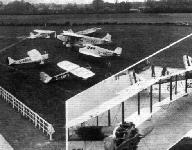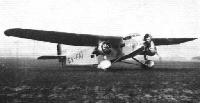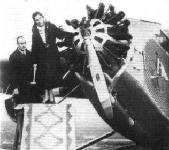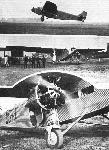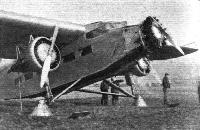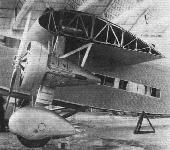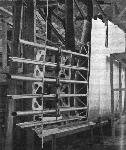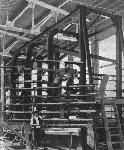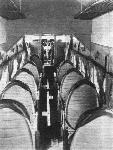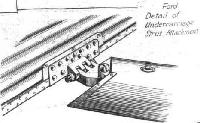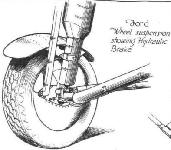
Описание
Страна : США
Год : 1926
Транспортный самолет с экипажем ив одного или двух человек
Варианты
- Stout - 2-AT Air Pullman - 1924 - США
- Ford - Tri-Motor / 4-AT / 5-AT - 1926 - США
- Stout - Bushmaster 2000 - 1964 - США
Ford Tri-Motor
Споры о том, действительно ли Уильям Б. Стаут является конструктором знаменитого самолета Ford Tri-Motor, продолжаются не один год. Не вызывает сомнений, что именно он сконструировал 2-AT Pullman, который компания "Stout Metal Airplane Company" выпускала в начале 1925 года. В августе того же года компания на правах отдельного подразделения вошла в состав компании "Ford Motor Company", после чего специалисты данного подразделения приступили к работам над трехмоторным вариантом Pullman, получившим обозначение Ford 3-AT Tri-Motor. Влияние самолета Pullman хорошо прослеживалось во внешнем виде машины: самолет представлял собой свободнонесущий высокоплан цельнометаллической конструкции, с такой же как у 2-AT гофрированной обшивкой. Однако если 2-AT, оснащенный одним двигателем Liberty, являлся достаточно изящным самолетом, то 3-AT, выпущенный в единственном экземпляре и отличавшийся тремя незакапотированными двигателями, расположенными по одному на каждой консоли крыла и в носовой части фюзеляжа, может быть легко отнесен к категории "безобразных" летательных аппаратов.
Последовавший затем аэроплан 4-AT, совершивший первый полет 11 июня 1926 года, в целом имел схожую компоновку, с подкосным хвостовым оперением и неубирающимся шасси с хвостовым костылем, в котором главные опоры шасси были значительно усовершенствованы. Самолет пилотировал экипаж из двух человек, находившийся в открытой кабине, расположенной перед крылом, а восемь пассажиров размещались в закрытом салоне. Один из трех звездообразных двигателей Wright Whirlwind J-4 мощностью 200 л.с. (149 кВт) был установлен в носовой части фюзеляжа, а два других - в мотогондолах, размещенных на моторамах под каждой консолью крыла. Такая компоновка оставалась практически неизменной до окончания в 1933 году серийного выпуска машины. Самолет выпускался в двух основных серийных модификациях - 4-AT и 5-AT, последний появился в 1928 году и отличался большей вместимостью.
Получивший прозвище "Tin Goose", самолет Tri-Motor выпускался также в виде целого ряда официальных и неофициальных подвариантов, с колесным, поплавковым и лыжным шасси. Данные самолеты использовались в Армии США под обозначениями XC-3, C-3, C-3A, C-4, C-4A, C-4B и C-9 (всего 13 машин), а также в ВМС и КМП США под обозначениями XJR-1, JR-2, JR-3, RR-1, RR-2, RR-3, RR-4 и RR-5 (всего 9 самолетов). Одним из доказательств высокой живучести конструкции Tri-Motor может служить такой пример: один из самолетов (5-AT-C) находился в коммерческой эксплуатации в своем первоначальном состоянии с момента его выпуска в 1929 году и вплоть до 1991 года.
Варианты
4-AT-A: начальный серийный вариант; построено 14 самолетов
4-AT-B: вариант 1927 года, с двигателями Whirlwind J-5 мощностью по 220 л.с. (177 кВт) и вместимостью 12 пассажиров; построены 39 самолетов
4-AT-C: схож с 4-AT-B, но с установленным в носовой части фюзеляжа звездообразным ПД Pratt & Whitney Wasp мощностью 400 л. с. (298 кВт); построен один самолет
4-AT-D: обозначение трех самолетов, схожих с 4-AT-B, но имевших различные силовые установки и отличавшихся индивидуальными доработками
4-AT-E: в основном идентичен 4-AT-B, но с тремя двигателями Whirlwind J-6-9 мощностью по 300 л.с. (224 кВт); построены 24 самолета
4-AT-F: один самолет, отличавшийся от 4-AT-E некоторыми аэродинамическими улучшениями
5-AT-A: серийный вариант 1928 года; размах крыла был увеличен на 1,17 м; самолет рассчитан на 13 пассажиров; в составе силовой установки были применены три звездообразных двигателя Wasp мощностью 420 л.с. (313 кВт); построены три самолета
5-AT-B: схожий с 5-AT-A, но вместимость 15 пассажиров; построен 41 самолет
5-AT-C: схожий с 5-AT-A, но вместимость 17 пассажиров; построен 51 самолет
5-AT-CS: морской вариант самолета 5-AT-C (с двумя поплавками Edo); построен один самолет
5-AT-D: отличие от модели 5-AT-C заключалось в поднятом на 0,2 м крыле для увеличения высоты салона; построены 20 самолетов
5-AT-DS: морской вариант 5-AT-D (с поплавками Edo); построен один самолет
5-AT-E: вариант с внешними двигателями, смещенными к передней кромке крыла
6-AT-A: эквивалент 5-AT-C, но с тремя двигателями Whirlwind J-6-9 мощностью по 300 л.с. (224 кВт); построены три самолета
6-AT-AS: морской вариант самолета 6-AT-A (поплавковое шасси Edo); построен один самолет
7-AT-A: новое обозначение одного самолета 6-AT-A после установки в носовой части двигателя Wasp мощностью 420 л. с. (313 кВт); позднее был модифицирован в вариант 5-AT-C
8-AT: грузовой вариант самолета 5-AT-C (одна машина), два двигателя на крыле сняты
9-AT: обозначение 4-AT-B после установки трех двигателей Wasp Junior мощностью по 300 л. с. (224 кВт)
11-AT: обозначение 4-AT-E с двигателями Packard мощностью по 225 л.с. (168 кВт), позже модифицирован в вариант 4-AT-B
13-A: обозначение самолета 5-AT-D с двигателем Wright Cyclone мощностью 575 л.с. (429 кВт) в носовой части и двумя двигателями Whirlwind J-6-9 мощностью по 300 л. с. (224 кВт) на крыле; позже переоборудован в 5-AT-D
14-A: самолет первоначально оснащался четырьмя двигателями и имел обозначение 10-A, но затем его силовую установку модифицировали - один двигатель Hispano-Suiza мощностью 1100 л.с. (821 кВт) и два двигателя Hispano-Suiza мощностью по 715 л.с. (533 кВт); вместимость салона - 40 пассажиров; построен один самолет, но даже не облетан
XB-906: обозначение одного 5-AT-C, переоборудованного в бомбардировщик; разбился во время заводских испытаний
ТАКТИКО-ТЕХНИЧЕСКИЕ ХАРАКТЕРИСТИКИ
Ford 5-AT-D Tri-Motor
Тип: транспортный самолет с экипажем ив одного или двух человек
Силовая установка: три звездообразных ПД Pratt SWhitney R-1340-C1 или -SC1 Wasp мощностью по 420 л. с. (313 кВт)
Летные характеристики: макс, скорость на оптимальной высоте 241 км/ч; крейсерская скорость на оптимальной высоте 196 км/ч; начальная скороподъемность 335 м/мин; практический потолок 5640 м; дальность полета 885 км
Масса: пустого 3556 кг; максимальная взлетная 6123 кг
Размеры: размах крыла 23,72 м; длина 15,32 м; высота 3,86 м; площадь крыла 77,57 мг
Полезная нагрузка: до 17 пассажиров в закрытом салоне (максимальная масса полезной нагрузки 1698 кг)
Описание:
- Ford Tri-Motor
- Flight, June 1929
OLYMPIA AERO SHOW 1929 - Flight, November 1930
FORD THREE-ENGINED MONOPLANES
Фотографии
-
Air International 1985-07 / Model enthusiast
Регистрационный номер: N7684 Island Airlines operated Ford 4-AT-Bs in this livery during the 'fifties and 'sixties for regular services between islands in Lake Erie, Ohio, where the longest route was 11 miles (18 km), the shortest two miles (3.2 km). N7684, built in 1928, was c/n 4-AT-42.
-
Air International 1985-07 / Model enthusiast
Регистрационный номер: A7528 Delivered to the US Navy in 1927 as the XJR-1, with serial A7528, this was the fourth Ford Trimotor, 4-AT-4. It is shown with the later, rounded, wing tips that were fitted before the aircraft was written off in April 1930. The engines were 200 hp Wright J-4 radials.
-
Air International 1985-07 / Model enthusiast
This Ford 5-AT-B, c/n 5-AT-40, is typical of several delivered in the early '30s to Cia Mexicana de Aviacion, Pan American's associate in Mexico, although others had the later Mexican "XA" registrations. Engines in the 5-AT were 420 hp Wasps and the wing span was increased.
-
Air International 1985-07 / Model enthusiast
Регистрационный номер: N414H [2] N414H is a Ford 5-AT-C, 5-AT-74, first flown in September 1929. Restored post-war by American Airlines for publicity purposes, it is shown here in the markings of Scenic Airways of Las Vegas.
-
Мировая Авиация 138
Компания "Scenic Airways" из Лас-Вегаса даже в 1980-х годах эксплуатировала этот 5-AT на туристических маршрутах в Гранд Каньоне.
-
Air International 1985-07 / Model enthusiast
Регистрационный номер: CF-BEP [3], G-CYWZ [3] Ford 6-AT-1, with Wright J-6 engines, was delivered to the RCAF in June 1929 as G-CYWZ and flew on floats or skis for much of its life, later becoming CF-BEP in airline service.
-
Aeroplane Monthly 1993-02 / M.Oakey - Grapevine
Регистрационный номер: N9651 Florida-based collector Kermit Weeks snapped up Ford Trimotor N9651 at auction for $650,000 (£435,000) in November 1992. Formerly owned by Irving Perlitch, the 1929 transport had for many years been based at the Hill Country Museum near Morgan Hill, California. N9651 joins Weeks’s other Trimotor, which was badly damaged by Hurricane Andrew last August.
-
Aeroplane Monthly 1997-06 / M.Vines - Kermit weeks's Fantasy of Flight
Ford Tri-Motor 5-AT-V c/n 34 was built in 1929 and featured in the film Indiana Jones and the Temple of Doom. Behind it is one of the four remaining Curtiss SNC-1 Falcons, which dates from 1939 and served in Bolivia and the Dutch East Indies.
Другие самолёты на фотографии: Curtiss-Wright CW-22 Falcon II - США - 1940
-
Авиация и Космонавтика 2021-06 / Некоторые знаменательные даты июня в истории авиации
Регистрационный номер: NC8407 -
Мировая Авиация 49
Регистрационный номер: N9683 [2] "Aircraft Hydro-Forming Inc." вывезла этот Model 5-AT Tri-Motor из Мексики и восстановила, после чего самолет в 1960-е годы эксплуатировала компания "American Airlines". На снимке самолет установлен на одной стоянке с авиалайнером Boeing 727-23 "Astrojet", полученным авиакомпанией в 1964 году.
Другие самолёты на фотографии: Boeing Boeing 727 - США - 1963
-
Air Pictorial 1991-10 / M.Gradidge - Gateway to Aviation
A general view of the Warbirds area, with the Ford 5-AT-E in military colours in the foreground and the Greenland Expedition DC-3 N99FS next to one of the three B-17Gs.
Другие самолёты на фотографии: Boeing B-17E / B-17G Flying Fortress - США - 1941Douglas DC-3 / C-47 Skytrain/С-53 Skytrooper / Dakota - США - 1935
-
Авиация и Космонавтика 2020-03 / В.Морозов - Отчаянное время, отважные женщины
«Форд-Тримотор» был простой, живучей и надежной машиной. На этом фото экземпляр «Тримотора», еще летавший в США в 1952 г.
-
Aeroplane Monthly 1998-09 / F.Mormillo - High country - low turnout
Two eras of Grand Canyon pleasure-flying: Steve Hinton flying the ex-Scenic Airlines Ford 5-AT Tri-Motor in formation with a Grand Canyon Airlines Twin Otter being piloted by Daniel Reich and Mark Durian.
Другие самолёты на фотографии: De Havilland Canada DHC-6 Twin Otter - Канада - 1965
-
Aeroplane Monthly 1999-10 / T.Harmsworth - Over the Moon and under the 'Kosh /Oshkosh '99 report/
Just a part of the Oshkosh scenery, snapped from the EAA’s $35-a-trip Ford Tri-Motor, with the classic park in the middle and to the right.
-
Мировая Авиация 49
В первом трехмоторном Model 4-AT отчетливо видны элементы конструкции самолета 2-AT - полукруглые иллюминаторы салона, открытая кабина пилотов. Позже самолеты 4-AT, получившие иллюминаторы иной формы и закрытую кабину летчиков, использовались фирмой Форда на линии Детройт - Кливленд.
-
Aviation Historian 4 / American Classics
The US Army took delivery of its first Tri-Motor ten months after the Navy received its first example. Tri-Motor production for the Army comprised one C-3, seven C-3As, one C-4 and four C-4As. The C-3As were redesignated C-9s upon delivery. This C-9, 29-224, first flew on June 18, 1929, and is seen here at Floyd Bennett Field in April 1931. Note the insignia of the Air Corps Technical School at Chanute Field on the fuselage sides. The aircraft was surveyed at the San Antonio Air Depot on November 1, 1934, as having accrued 1,794 hr of flying time.
-
Flight 1930-02 / Flight
A Ford all-metal monoplane arrives at Madrid for the Madrid-Paris line. It was embargoed at Seville by the Junkers Co. regarding patent rights, but later released under bond.
-
Flight 1931-01 / Flight
DIESEL-ENGINED: A Ford type 4-AT, fitted with three Packard Diesel engines of 225 b.h.p. each. With these engines the machine has a cruising speed of 100 m.p.h. It carries two pilots and 11 passengers.
-
Flight 1930-11 / Flight
THE FORD 4-AT-E: Note the streamline fairings over the wheels. The propellers are standard metal airscrews with adjustable pitch blades. Starting is by means of hand-operated inertia starters, one being carried in each nacelle and one in the fuselage.
-
Авиация и Космонавтика 2020-03 / В.Морозов - Отчаянное время, отважные женщины
Пассажиры перед посадкой в «Форд-Тримотор». США, конец 1920-х гг.
-
Flight 1930-10 / Flight
THE AMERICAN WAY OF STARTING: Three men swinging the inertia starter on the Ford monoplane, one holding the end of the starting handle and the other two "cranking."
-
Flight 1926-10 / Flight
U.S. AIR MAIL SERVICES. C.A.M. Nos. 6 and 7. For the future three-engined (Wright "Whirlwind") Ford-Stout all-metal monoplanes, as shown in the photograph, will be used.
-
Flight 1929-02 / Flight
Lady Heath's Gipsy-Moth at Fayetteville at dawn during the flight from New York to Miami. The other machine is a three-engined Ford monoplane.
Другие самолёты на фотографии: De Havilland Gipsy Moth / Moth X - Великобритания - 1928
-
Flight 1931-07 / Flight
A VISITOR TO ALL CONTROLS : The three-engined Ford (Wasps) is here seen at Whitchurch (Bristol).
-
Aeroplane Monthly 1984-01 / F.Winstanley - Those Celluloid Flying Fools (1)
A Ford Trimotor undergoing an aft c.g. check in 1930 over Miami with James Terry playing the role of tail end Charlie.
-
Flight 1929-07 / Flight
The only American representative: The tri-motored Ford monoplane is of all-metal construction
-
Aviation Historian 4 / American Classics
Регистрационный номер: A7526 The US Navy was the first American military service to acquire a Ford Tri-Motor. The first XJR-1 (serial A7526) was the fourth Tri-Motor built and made its first flight on January 29, 1927, before it was delivered to the Navy that March. After it was damaged by a tornado on November 18, 1927, repairs were made and the aircraft was operated until April 1930, when it was scrapped at Philadelphia.
-
Aviation Historian 4 / American Classics
With its spacious interior the ubiquitous Tri-Motor was ideal for testing the bulky airborne radio equipment of the day. Two large antennae are clearly visible atop the fuselage of this C-9, which has markings that leave no doubt as to its purpose, alongside Wright Field’s distinctive “arrow” marking. Early tests on radio-controlling another aircraft were performed at Wright Field, but the concept would not be perfected until the late 1930s. The C-9 variant replaced the C-3A’s 235 h.p. Wright R-790-3 engines with a trio of 300 h.p. Wright R-975-1s.
-
Aeroplane Monthly 1978-12 / Personal album
Регистрационный номер: G-ABEF [9], NC9678 [9], VH-UDY [9] Ford 4AT-E Trimotor G-ABEF Vagabond was purchased by Holdens Air Transport Ltd from British Air Navigation Co Ltd at Heston through W. S. Shackleton in June 1935, and became VH-UDY. Powered by three 300 h.p. Wright Whirlwinds, it was originally Ford’s demonstrator NC9678. It is seen at Salamaua, New Guinea, in 1936.
-
Flight 1932-08 / Flight
Регистрационный номер: G-ABEF [9], NC9678 [9], VH-UDY [9] HEAVY TRANSPORT AT SKEGNESS: The three-engined Ford, piloted by Maj. F. Digby.
-
Aeroplane Monthly 1987-07 / Personal album
Регистрационный номер: G-ABEF [9], NC9678 [9], VH-UDY [9] View of the Ford 4AT-E G-ABEF, Ford’s UK demonstrator, photographed at the Skegness Air Pageant on July 31, 1932. It was the largest aircraft ever to land on that aerodrome. Following sale to two British companies the Ford was sold to Guinea in July 1934 and was re-registered VH-UDY.
-
Aeroplane Monthly 1987-07 / Personal album
Регистрационный номер: G-ABEF [9], NC9678 [9], VH-UDY [9] -
Air-Britain Archive 1986-04
Регистрационный номер: G-ABEF [9], G-ABFF [5], G-ABHF [5], NC9678 [9], VH-UDY [9] The Ford Trimotors G-ABEF (Wright Whirlwinds) and G-ABFF (Pratt & Whitney Wasps) on arrival at Heston 21.10.30 from Liverpool after assembly. The larger 5-AT-C G-ABFF was later re-registered G-ABHF after Henry Ford.
-
Flight 1930-10 / Flight
Регистрационный номер: G-ABEF [9], NC9678 [9], VH-UDY [9] -
Flight 1930-11 / Flight
Регистрационный номер: G-ABEF [9], NC9678 [9], VH-UDY [9] TYPE 4-AT-E: Fitted with three Wright "Whirlwind" engines, this is the smaller of the two machines now in Europe.
-
Flight 1930-10 / Flight
Регистрационный номер: G-ABEF [9], NC9678 [9], VH-UDY [9] THE FORD TYPE 4-AT-E: Fitted with three Wright J.6 "Whirlwind" engines this machine carries 11 passengers and 2 pilots. Standing under the wings of the Ford are two Comper "Swifts," that on the left being the "Scorpion" version, while that on the right has a Pobjoy engine.
Ford 4-AT-E G-ABEF was assembled at Hooton by Compers in October 1930, and is seen here in company with Swifts ZK-ACG and G-AAZF.Другие самолёты на фотографии: Comper Swift / CLA.7 - Великобритания - 1930
-
Flight 1929-07 / Flight
Регистрационный номер: NX4542 [2] THE ONLY AMERICAN REPRESENTATIVE: The tri-motored Ford monoplane.
The Floyd Bennett (28-29 November 1929). -
Мировая Авиация 49
Регистрационный номер: NX4542 [2] Адмирал Ричард Бёрд получил зтот доработанный 4-AT-B (регистрационный номер NX4542, собственное имя "Floyd Bennett" в честь его бывшего пилота) от фирмы "Ford" для планировавшегося первого полета над Южным полюсом. Ранее Бёрд использовал самолет Fokker F.Vll/3m для своей арктической полярной экспедиции. Полет длительностью 18 ч 50 мин и продолжительностью 2575 км состоялся 28-29 ноября 1929 года, самолетом управлял Бернт Бальхен. Для увеличения дальности и продолжительности полета на самолете были установлены дополнительные топливные баки. При доработке был увеличен размах крыла, двигатели Wright J-5 заменены на Wright Cyclone. Ныне самолет экспонируется в музее Форда в Дирборне, штат Мичиган.
-
Flight 1932-05 / Flight
Регистрационный номер: G-ABEF [9], NC9678 [9], VH-UDY [9] SCENES AT HESTON: Some of the commercial aircraft which were on view - ABGK, Lockheed "Vega"; ABLI, Spartan Mailplane; ABEF, Ford; ABDC, Junkers; ABDH and ABFV, "Puss Moths."
Другие самолёты на фотографии: De Havilland Puss Moth / D.H.80 - Великобритания - 1929Junkers F 13 - Германия - 1919Lockheed Vega - США - 1927Spartan Cruiser - Великобритания - 1932
-
Flight 1931-10 / Flight
Регистрационный номер: G-ABHF [5], G-ABFF [5] PEDIGREE FORDS: Prize sheep from the flock of Mr. John Langmead, of Ford, Sussex, under the wing of one of the Ford monoplanes.
-
Flight 1931-04 / Flight
Регистрационный номер: CV-FAI The Ford monoplane on which Prince Bibesco is making a tour of the aerodromes of Europe and Asia.
-
Air-Britain Archive 1985-04
Регистрационный номер: G-ACAE Two Heston landmarks are visible behind Ford Trimotor G-ACAE, the distinctive Airwork hangar and the pyramidal refuelling station topped off by a clock.
-
Aeroplane Monthly 1989-06 / Personal album. Civil
Регистрационный номер: G-ABHO [3], NC401H [3] Ford 5-AT-C G-ABHO, formerly NC401H in the USA, was imported into the UK in 1930, having first flown in July the previous year. The 14-passenger tri motor was powered by three 420 h.p. Wasps and was first owned by Lord Lovelace and based at Heston.
-
Flight 1934-05 / Flight
Регистрационный номер: G-ABHO [3], NC401H [3] A LARGE VISITOR AT JERSEY: Last week we illustrated the British Air Navigation Co.'s Tri-motor Ford, Voyager, at Heston prior to its departure for Jersey. This picture was taken on the sands at Jersey after its arrival.
-
Flight 1934-05 / Flight
Регистрационный номер: G-ABHO [3], NC401H [3] BUSY B.A.N.C.O.: Last Saturday the British Air Navigation Co.'s Tri-motor Ford, Voyager, was pressed into service between Heston and Jersey to transport an "overflow" load of nine passengers from the regular service. Here we see the passengers emplaning at Heston.
-
Jane's All the World Aircraft 1980 / Encyclopedia of Aviation - Aircraft A-Z - v3
Ford 5-AT Tri-motor.
-
Flight 1931-02 / Flight
One of the three-engined Ford airliners, employed by National Air Transport (Inc.) of America, with the ingenious wing mail compartments.
-
Flight 1931-02 / Flight
How the mails are placed in the ingenious wing mail compartments is shown in the top picture, while the lower picture shows an interior view of the compartment.
-
Flight 1931-04 / Flight
"COMTE DE LA VAULX": Princess Bibesco christens the Ford monoplane on which Prince Bibesco is making a tour of the aerodromes of Europe and Asia.
-
Flight 1929-09 / Flight
Three views of the all-metal Ford Commercial Monoplane, which recently carried out demonstrations at Croydon. This machine, which was exhibited at the Olympia Aero Show, has three 425 h.p, Pratt and Whitney "Wasp" engines.
-
Авиация и Космонавтика 2016-06 / Знаменательные даты июня в истории авиации
Регистрационный номер: N9683 [2] -
Air Pictorial 1977-10 / J.Gradidge - Oshkosh
Регистрационный номер: N414H [2] Oshkosh would not seem right without a Ford Trimotor 5-AT-CS giving rides, but this was N414H's last appearance as it is being retired by the Lemsters and will work out its days with Grand Canyon Airways. It is the last airworthy Ford
-
Aviation Historian 4 / American Classics
US Navy Ford RR-5 9206 is seen here at Floyd Bennett Field, New York, in 1935. This Tri-Motor was delivered to Naval Air Station (NAS) Anacostia on February 17, 1932, before moving on to NAS Pensacola in December 1934. In service, the Fords were used for a variety of duties, from transporting VIPs to carrying cargo between bases. As may be seen, markings were minimal. This aircraft flew some 2,784 hours, making it the most flown Ford in the Navy/Marine fleet. The aircraft was withdrawn in July 1940 with the notation “worn out”.
-
Мировая Авиация 49
Для ВВС США были построены 22 самолета: 13 для Авиационного корпуса Армии США и девять для ВМС и Корпуса морской пехоты. Все в транспортном варианте. Армия получила восемь 4-AT и пять 5-AT (военные обозначения в зависимости от варианта C-3, C-4, C-4A и C-9). Флот и морская пехота также закупили самолеты обеих модификаций, получившие обозначения XJR-1, JR-2, JR-3, RR-4 и RR-5. На снимке - RR-5, один из двух 5-AT-D, поступивших на вооружение ВМС. 5-AT-D именовали "Ford с высоким крылом", так как его центроплан был приподнят на 20 см для увеличения высоты кабины. Другим отличием являлась дверь прямоугольной формы. "Ford" также построил бомбардировочный вариант самолета Tri-Motor (XB-906-1). ВМС США была предложена модификация на поплавках, способная нести две торпеды, однако заказа на постройку такого самолета.
-
Aviation Historian 4 / American Classics
Регистрационный номер: A8840 The Navy acquired nine Tri-Motors: one XJR-1; two JR-2s; three JR-3s; one RR-4 and two RR-5s. In January 1935 the RR-4, A8840, was flown to the Naval Aircraft Factory for overhaul, after which it was handed over to the US Marine Corps at Quantico, Virginia. Overly keen use of the brakes put the machine on its nose on March 1, but it was soon repaired and went on to fly with VJ-6M. The machine had a short service life, being stricken from service on May 29, 1937.
-
Aviation Historian 4 / American Classics
Регистрационный номер: A8598 Ford JR-3 A8598 made its first flight on December 27, 1929, and was transferred directly to the Marines from a Navy order. The Tri-Motor stayed at the factory, where it is seen here, until April 30, 1930, when it was flown to Nicaragua, where the Corps was fighting rebel forces. On August 4, 1930, the aircraft suffered a landing accident and caught fire at Ocotal, but the pilot escaped from the burning machine with no injuries.
-
Flight 1930-03 / Flight
A tri-motored metal Ford monoplane, the type employed by the Mexican Aviation Co. on the air services operated by them.
-
Мировая Авиация 49
Регистрационный номер: N76GC [2] В 1970-1980 годы компания "Scenic Airways Inc." из Лас-Вегаса использовала этот самолет для полетов с туристами над Большим Каньоном и другими местными достопримечательностями.
-
Aeroplane Monthly 1983-01 / B.Gunston - The classic aero engines (5)
Регистрационный номер: N76GC [2] The three 450 h.p. Pratt & Whitney Wasps turning on a Scenic Airlines Ford Tri-motor N76GC at McCarron Field near Las Vegas.
-
Мировая Авиация 49
Регистрационный номер: XA-HIL Самым известным "долгожителем", выпущенным компанией "Ford", стал 5-AT-11, который летал в "Pan American" и TACA (Колумбия), а в августе 1945 года был куплен за 4500 долларов мексиканской авиакомпанией "TATSA", где получил регистрацию XA-HIL. Самолет использовался для перевозки людей и грузов между Масатланом и расположенным в районе Дуранго в каньоне небольшим аэродромом, обслуживавшим шахту. Самолет налетал на этих маршрутах 5376 ч, перевез более 65 000 пассажиров и порядка 7400 т грузов без единого происшествия. В 1966 году, когда записанный в паспорте самолета налет достиг почти 23 000 ч, машину купила авиакомпания "Island Airlines" из Порт-Клинтона, штат Огайо, эксплуатировавшая его до 1980-х годов в качестве туристского. В 2009 году самолет-ветеран занял достойное место в коллекции аэрокосмического музея в Сан-Диего.
-
Aeroplane Monthly 1978-03 / R.Williams - The Siskin saga (2)
Регистрационный номер: G-CYWZ [3], CF-BEP [3] Five RCAF Siskin IIIAs, with 23 and 60 nearest, during a trans-Canada flight in 1931. In the distance is Canada's sole military Ford Trimotor, G-CYWZ.
Другие самолёты на фотографии: Armstrong Whitworth Siskin - Великобритания - 1921
-
Air International 1995-11 / G.Jones - Northwest is Northbest
Регистрационный номер: NC8410 Fourteen-passenger Ford Tri-motors were added to the Northwest fleet in 1928. This particular aircraft, serial no 5-AT-48, registration NC8410, was photographed in the summer of 1932.
-
Air-Britain Archive 1986-04
Регистрационный номер: G-ABFF [5], G-ABHF [5] Ford 5-AT-C demonstrator G-ABFF showing its paces shortly after arriving in the UK in October 1930. In January 1931 it was re-registered with Henry Ford's initials as G-ABHF.
-
Flight 1931-10 / Flight
Регистрационный номер: G-ABHF [5], G-ABFF [5] HENRY FORD, HIS MARK: The "Wasp" powered 5AT demonstrator with its appropriate registration letters flying over its home aerodrome.
-
Flight 1931-10 / Flight
Регистрационный номер: G-ABHF [5], G-ABFF [5] SOLID BEAUTY: The 5AT is a very graceful machine and although quite fast - its top speed is 150 m.p.h. - does not, in consequence, lose its air of solid comfort. The centre engine will in future also have a Townend ring type of cowling around it.
-
Мировая Авиация 138
Данный C-4A - один из вариантов Tri-Motor, летавших в авиакорпусе Армии США в качестве транспортных машин.
-
Flight 1934-06 / Flight
THE FORD FREIGHTER: The Tri-motor Ford which, in conveying machinery, etc., to the mines 12,000 ft. up, has to clear part of the Andes into the bargain!
-
Flight 1937-02 / Flight
SOURDOUGH: A real old-timer from the frozen wastes of Alaska, this Ford trimotor flew down to Boeing Field complete with skis and made an exemplary landing on the snowless grass.
-
Мировая Авиация 49
Военные Tri-Motor эксплуатировались не только ВС США, но и ВВС Австралии, Канады и Республиканской Испании. Model 5-AT-CS - один из четырех самолетов данного типа с поплавковым шасси, закупленных ВВС Чили.
-
Мировая Авиация 138
Вариант 5-AT-CS отличался дополнительным подфюзеляжным килем.
Ford 5-AT-CS Tri-motor with twin-float landing gear. -
Air Pictorial 1957-03
Регистрационный номер: CF-BEP [3], G-CYWZ [3] Ford Trimotor "WZ" (later CF-BEP) was used for various duties including crop-dusting during its career. After service with the R.C.A.F. it was bought by G. W . G. McConachie, who was one of the founders of Canadian Pacific Airways.
-
Flight 1930-11 / Flight
THE TYPE 5-AT-C: The wing ends were not yet in place when this photograph was taken at Hooton. Note the tank inside the centre section, and the cowling ring around the "Wasp" engine.
-
Flight 1931-07 / Flight
H.R.H. The Prince of Wales showed great interest in the 3-engined Ford and is here seen emerging after having looked over it, together with Capt. Baker the Chief Instructor at Heston.
-
Flight 1931-10 / Flight
DETAILS THAT COUNT: Great attention has been paid to the streamlining of such details as the undercarriage on the 5AT Pullman. The way in which the radius rod and axle are faired into the "spat" is shown very clearly in these pictures.
-
Flight 1930-11 / Flight
THE TYPE 5-AT-C: The castor-section tail wheel.
-
Flight 1932-01 / Flight
AN OLD SPANISH CUSTOM FROM THE AIR: A fine aerial view of the Madrid Bull Ring and adjacent football ground taken from a three-engined Ford monoplane supplied to the Spanish Government. The car park is clearly visible in the foreground and the propeller and nose of the plane can be seen on the right.
-
Flight 1929-11 / Flight
THE FIRST CANADIAN AIR PAGEANT AT MONTREAL: The U.S. Army Curtis PI's are formating on the left. On the left is a Ford Tri-motor, while next to it are two Lockheeds, with N.A.C.A. cowling and speeds of about 190 m.p.h. The one with the dark fuselage is Capt. Hawks' transcontinental record machine.
Другие самолёты на фотографии: Curtiss F6C / P-1 / Hawk / Model 34 - США - 1925Lockheed Air Express 3 - США - 1928
-
Flight 1930-11 / Flight
FORD WING SPAR CONSTRUCTION: Built of Duralumin, the spar has "D"-section flanges, as shown on the right in A, while the vertical and diagonal struts are plain channel sections, as in B.
-
Flight 1930-11 / Flight
FORD WING CONSTRUCTION: There are three main spars, built up as shown on p.1234, and between them light stringers of U section, as in C. The struts of the stringer system are of the section shown in D.
-
Flight 1930-11 / Flight
A WING TIP NEARING COMPLETION: Note the type of rib used near the wing tip, and the disappearance, due to taper, of the N girders of the spars.
-
Flight 1930-11 / Flight
ASSEMBLING IN A VERTICAL JIG: This photograph, taken in the Dearborn works of the Ford Company, gives a good idea of the elaborate jigging used in wing assembly. The wings are erected leading edge downwards.
-
Flight 1930-11 / Flight
THE COCKPIT OF A THREE-ENGINED FORD: The central lever operates the wheel brakes (hydraulic).
-
Flight 1929-07 / Flight
A view inside the cockpit of the tri-motored Ford, showing dual controls and hydraulic brake handle.
-
Flight 1929-07 / Flight
A peep into the saloon of the Ford tri-motored monoplane.
-
Flight 1930-11 / Flight
THE CABIN: In the floor may be seen the special louvres which admit warm air. The open door shows a little of the pilots' cockpit.
-
Jane's All the World Aircraft 1980 / Encyclopedia of Aviation - Aircraft A-Z - v3
Interior of a National Air Transport Ford Tri-motor.
-
Aeroplane Monthly 1999-06 / M.Oakey, T.Harmsworth - News
Регистрационный номер: N9637 Not much space to spare: the Ford Tri-Motor N9637 in the museum’s basement.
-
Air-Britain Aeromilitaria 1987-03
Регистрационный номер: X5000 Following the Ford Trimotor query in recent issues, Andy Thomas submits this photograph of X5000, camouflaged and in a ditch at Ballyminerra, Co Down on September 19, 1940, as a result of an overshot landing in bad weather while serving with 271 Squadron. It was probably a write-off.
-
Air-Britain Archive 1983-03
The two photos illustrate the accident of 24.6.35 at Medellin, Colombia involving SACO Ford 5-AT registered F-31, the remains of which can be clearly seen in the lower photograph. This aircraft carried the world's leading tango singer Carlos Gardel, "The Native Thrush", who was perhaps the most popular singer in Latin America at the time. Through his death the accident made headlines all over the world. The upper photo shows the other end of the collision, the tailplane of SCADTA's Ford 5-AT "Manizales". It is the different, more triangular, shape of this fin and rudder which identify this aircraft as almost certainly c/n 5AT-112.
-
Мировая Авиация 49
Регистрационный номер: NC9688 5-AT-B Tri-Motor. NC9688 стал последним из десяти самолетов 5-AT-B, поставленных в 1928-1932 годах авиакомпании "Pan American" - основному эксплуатанту самолетов Tri-Motor. Главным образом, они использовались в ее дочерних латиноамериканских компаниях - мексиканской СМА ("Compania Mexicana de Aviacion"), колумбийской "SCADTA", кубинской "Cubana" и "Panagra" (зарегистрированная в США компания, которая выполняла рейсы только в Латинской Америке). Парк самолетов Tri-Motor авиакомпании "Pan American" включал четыре машины Model 4-AT-E, десять Model 5-AT-B, восемь Model 5-AT-C и шесть Model 5-AT-D. Изначально NC9688 был поставлен в Мехико, но в декабре 1934 года его передали авиакомпании СМА, где он получил регистрацию XA-BCW. Самолет потерпел аварию 5 марта 1940 года недалеко от вулкана Сан-Мартин, обошлось без жертв.
-
Мировая Авиация 49
5-AT-D Tri-Motor
-
Flight 1929-08 / Flight
Ford Detail of Undercarriage Strut Attachment
-
Flight 1929-08 / Flight
Ford Wheel suspension showing Hydraulic Brake
-
Flight 1929-07 / Flight
A castor-action wheel is used instead of a tail skid on the Ford tri-motored monoplane.
-
Мировая Авиация 138
Ford 5-AT Tri-Motor
- Фотографии






































